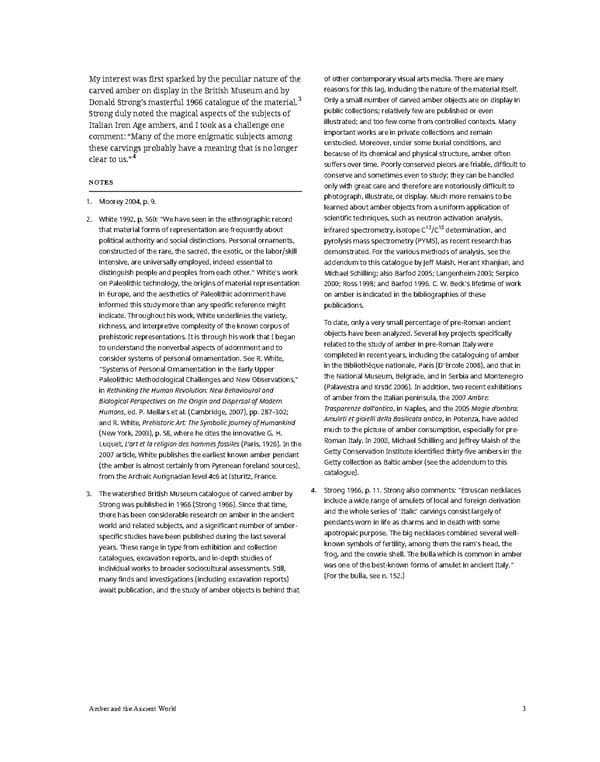My interest was first sparked by the peculiar nature of the of other contemporary visual arts media. There are many carved amber on display in the British Museum and by reasons for this lag, including the nature of the material itself. Donald Strong’s masterful 1966 catalogue of the material.3 Only a small number of carved amber objects are on display in Strong duly noted the magical aspects of the subjects of public collections; relatively few are published or even Italian Iron Age ambers, and I took as a challenge one illustrated; and too few come from controlled contexts. Many comment: “Many of the more enigmatic subjects among important works are in private collections and remain these carvings probably have a meaning that is no longer unstudied. Moreover, under some burial conditions, and clear to us.”4 because of its chemical and physical structure, amber often suffers over time. Poorly conserved pieces are friable, difficult to NOTES conserve and sometimes even to study; they can be handled only with great care and therefore are notoriously difficult to 1. Moorey 2004, p. 9. photograph, illustrate, or display. Much more remains to be learned about amber objects from a uniform application of 2. White 1992, p. 560: “We have seen in the ethnographic record scientific techniques, such as neutron activation analysis, that material forms of representation are frequently about infrared spectrometry, isotope C12/C13 determination, and political authority and social distinctions. Personal ornaments, pyrolysis mass spectrometry (PYMS), as recent research has constructed of the rare, the sacred, the exotic, or the labor/skill demonstrated. For the various methods of analysis, see the intensive, are universally employed, indeed essential to addendumto this catalogue by Jeff Maish, Herant Khanjian, and distinguish people and peoples from each other.” White’s work Michael Schilling; also Barfod 2005; Langenheim 2003; Serpico on Paleolithic technology, the origins of material representation 2000; Ross 1998; and Barfod 1996. C. W. Beck’s lifetime of work in Europe, and the aesthetics of Paleolithic adornment have on amber is indicated in the bibliographies of these informed this study more than any specific reference might publications. indicate. Throughout his work, White underlines the variety, To date, only a very small percentage of pre-Roman ancient richness, and interpretive complexity of the known corpus of objects have been analyzed. Several key projects specifically prehistoric representations. It is through his work that I began related to the study of amber in pre-Roman Italy were to understand the nonverbal aspects of adornment and to completed in recent years, including the cataloguing of amber consider systems of personal ornamentation. See R. White, in the Bibliothèque nationale, Paris (D’Ercole 2008), and that in “Systems of Personal Ornamentation in the Early Upper the National Museum, Belgrade, and in Serbia and Montenegro Paleolithic: Methodological Challenges and New Observations,” (Palavestra and Krstić 2006). In addition, two recent exhibitions in Rethinking the Human Revolution: New Behavioural and of amber from the Italian peninsula, the 2007 Ambre: Biological Perspectives on the Origin and Dispersal of Modern Humans, ed. P. Mellars et al. (Cambridge, 2007), pp. 287–302; Trasparenze dall’antico, in Naples, and the 2005 Magie d’ambra: and R. White, Prehistoric Art: The Symbolic Journey of Humankind Amuleti et gioielli della Basilicata antica, in Potenza, have added (New York, 2003), p. 58, where he cites the innovative G. H. much to the picture of amber consumption, especially for pre- Luquet, L’art et la religion des hommes fossiles (Paris, 1926). In the Roman Italy. In 2002, Michael Schilling and Jeffrey Maish of the 2007 article, White publishes the earliest known amber pendant Getty Conservation Institute identified thirty-five ambers in the (the amber is almost certainly from Pyrenean foreland sources), Getty collection as Baltic amber (see the addendum to this from the Archaic Aurignacian level 4c6 at Isturitz, France. catalogue). 3. The watershed British Museum catalogue of carved amber by 4. Strong 1966, p. 11. Strong also comments: “Etruscan necklaces Strong was published in 1966 (Strong 1966). Since that time, include a wide range of amulets of local and foreign derivation there has been considerable research on amber in the ancient and the whole series of ‘Italic’ carvings consist largely of world and related subjects, and a significant number of amber- pendants worn in life as charms and in death with some specific studies have been published during the last several apotropaic purpose. The big necklaces combined several well- years. These range in type from exhibition and collection known symbols of fertility, among them the ram’s head, the catalogues, excavation reports, and in-depth studies of frog, and the cowrie shell. The bulla which is common in amber individual works to broader sociocultural assessments. Still, was one of the best-known forms of amulet in ancient Italy.” many finds and investigations (including excavation reports) (For the bulla, see n. 152.) await publication, and the study of amber objects is behind that Amber and the Ancient World 3
 Ancient Carved Ambers in the J. Paul Getty Museum Page 12 Page 14
Ancient Carved Ambers in the J. Paul Getty Museum Page 12 Page 14